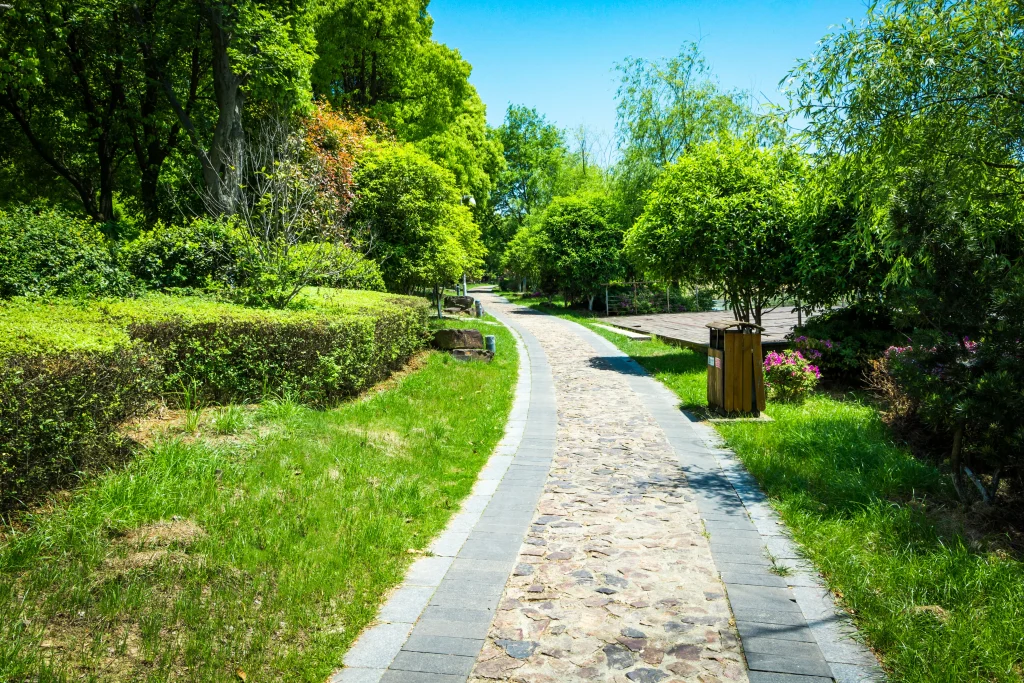Thousands of Denver homeowners are discovering that rock and mulch landscaping is a practical solution to Colorado’s challenging climate.
From bold boulder arrangements to cedar mulch beds that soften architecture, these 17 front yard rock and mulch landscape pictures showcase real transformations possible in Colorado’s Front Range. Each design handles our extreme temperature swings while reducing water consumption. Let’s find out!
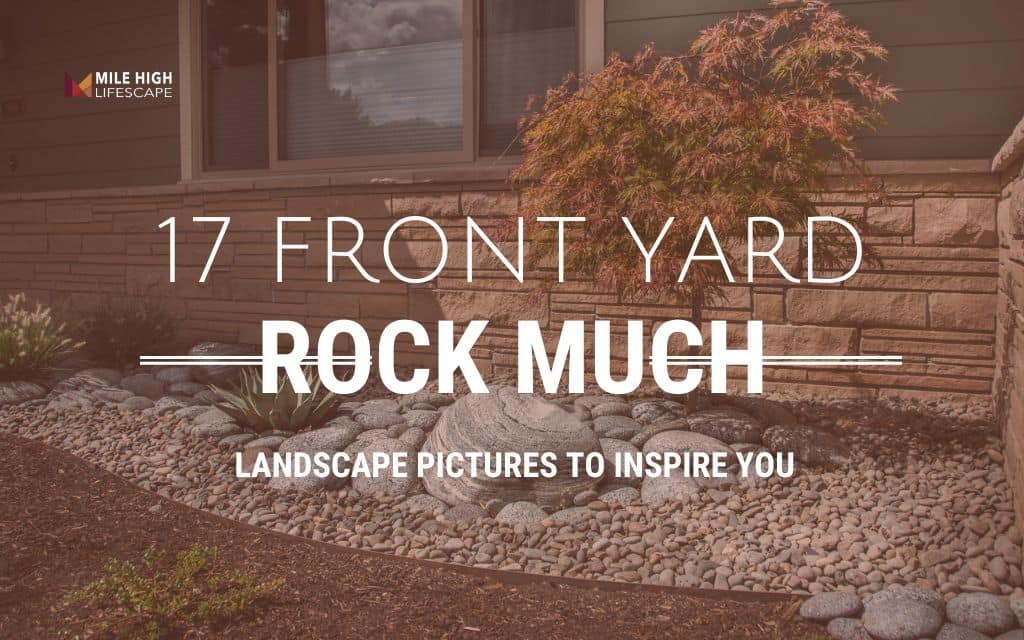
Why choose rock and mulch landscaping for Denver yards
Built for Colorado’s climate
Denver’s climate presents unique challenges that rock and mulch landscapes are specifically designed to handle. Rock and mulch designs excel in these conditions because they require minimal water. This helps homeowners avoid costly overwatering penalties during drought restrictions.
These landscapes also handle our intense sunlight and low humidity without deteriorating. While grass struggles and browns out during dry spells, rocks maintain their appearance indefinitely, and quality mulch products resist rapid decomposition.
The rapid freeze-thaw cycles that heave and crack concrete or damage plant roots have minimal impact on properly installed rock and mulch beds. The materials flex and shift naturally with temperature changes, maintaining their integrity year after year.
Sustainable and stylish
Rock and mulch landscapes combine environmental responsibility with attractive design. Rocks provide structural stability that prevents soil erosion. They direct water runoff during intense summer thunderstorms, protecting foundations and preventing washouts.
Organic mulches placed around plants improve soil quality over time, adding nutrients as they decompose and helping retain moisture. This combination creates healthier growing conditions without requiring chemical fertilizers or pesticides.
A smart, low-maintenance investment
Rock and mulch landscaping offers significant long-term value.
You’ll reduce irrigation system maintenance, sprinkler repairs, and summer water bills. No more weekend hours spent mowing, edging, fertilizing, or reseeding. Most rock and mulch landscapes need only 2 – 4 hours of monthly maintenance: light raking, occasional weeding, and annual mulch refreshing.
These landscapes are durable. Quality rocks maintain appearance for 10 – 15 years before needing adjustments. Organic mulches require replenishing every 1-2 years, but costs remain far below ongoing turf maintenance expenses.
17 Front yard rock & mulch landscape pictures to inspire you
River rock path with mulch borders
Smooth river stones in soft grays and tans create a welcoming pathway from sidewalk to front door. The stones, 2 – 4 inches in size, provide durable all-weather access that stays clean during rain and snowmelt. Dark bark mulch borders the path, creating a strong visual contrast while retaining moisture for plants like coneflowers, Russian sage, and ornamental grasses.
Read more: 21 landscape designs with river rock that transform ordinary yards into water-wise retreats
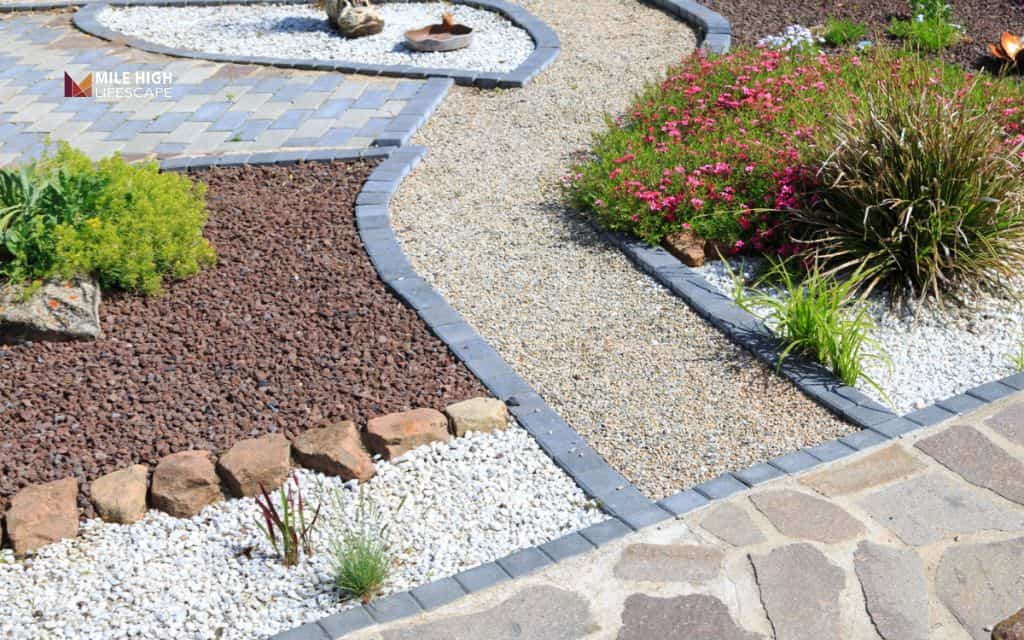
Xeriscape with lava rock and native grasses
Black lava rock creates a bold, contemporary backdrop that makes plants stand out dramatically. Its porous texture adds interest while the dark color absorbs heat. Pair with architectural plants like blue fescue, yucca, and sedum for a modern Southwest aesthetic that thrives in Denver’s dry climate.
Read more: 10 modern black rock landscape ideas for Denver homes
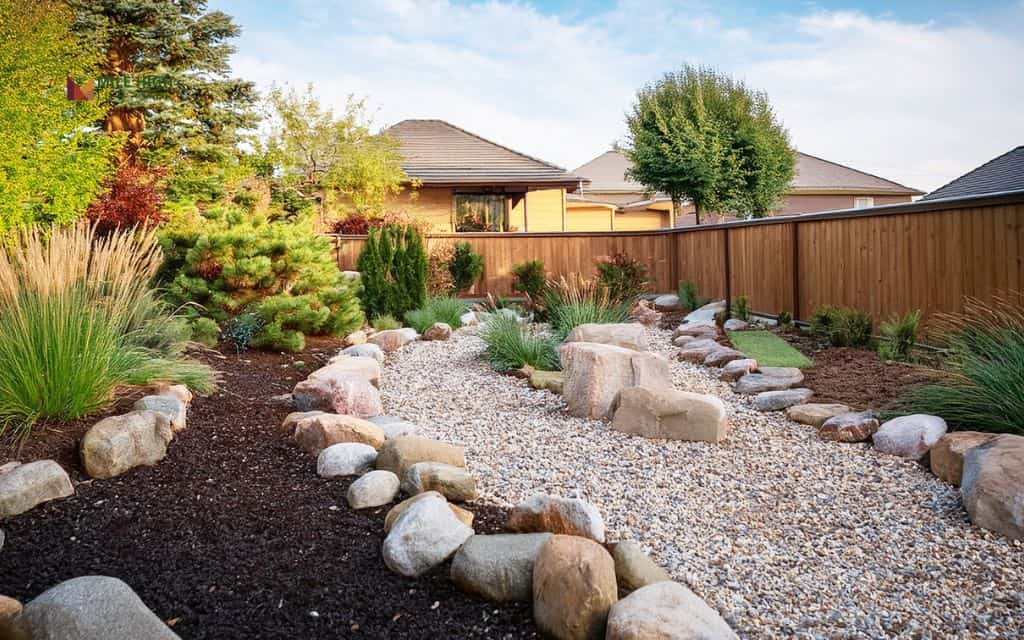
Curved rock edging with cedar mulch
Gray limestone or buff stone creates graceful curved borders between different landscape zones. The 6 – 10 inch stones are partially buried for stability. Inside, reddish-cedar mulch provides warmth and contrast, creating an inviting setting for perennials and ornamental grasses.
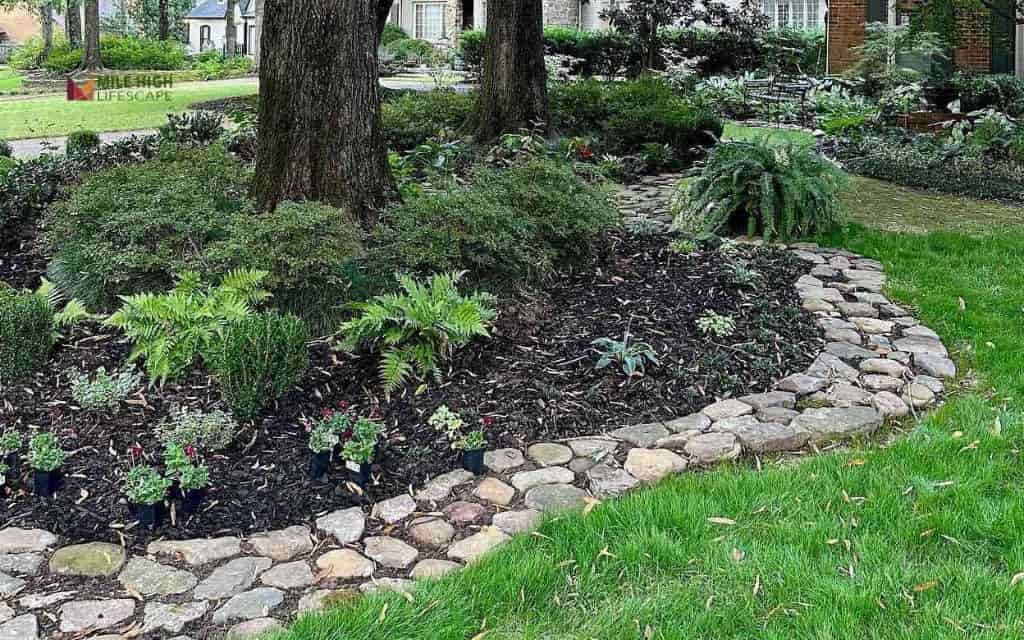
Rock-and-mulch layered beds
Large decorative stones (8 – 16 inches) placed atop dark mulch create three-dimensional texture and visual interest. The stones serve as focal points and anchor plantings, while mulch fills spaces between them and retains moisture for perennials like blanket flower and penstemon.
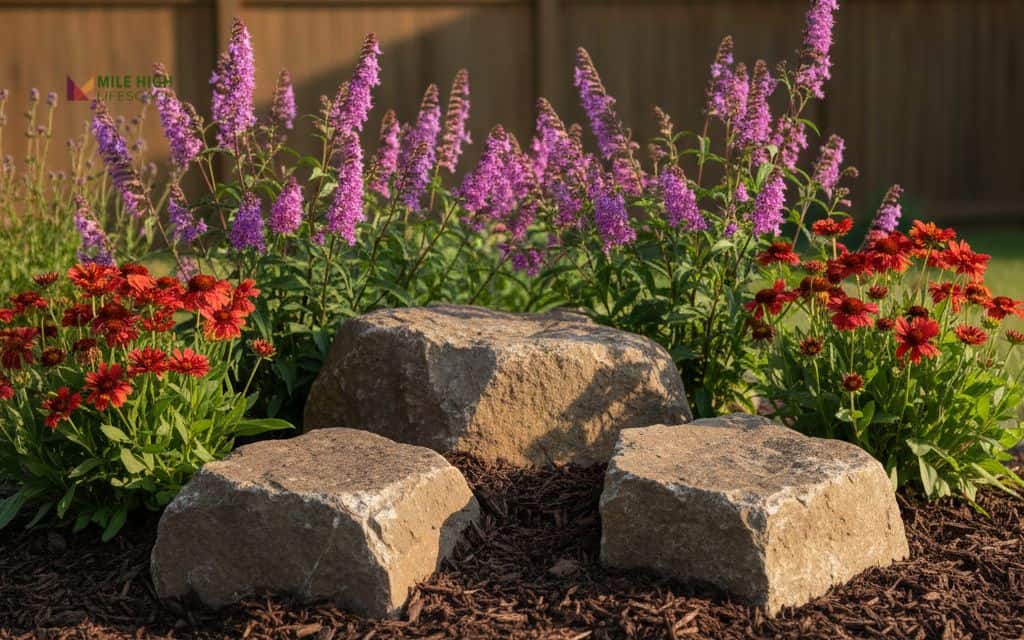
Stone garden with evergreen accents
White or light gray marble chips combined with compact evergreens provide year-round color through Denver winters. Dwarf junipers, compact spruces, and globe-shaped evergreens create sculptural forms against the bright stone background.
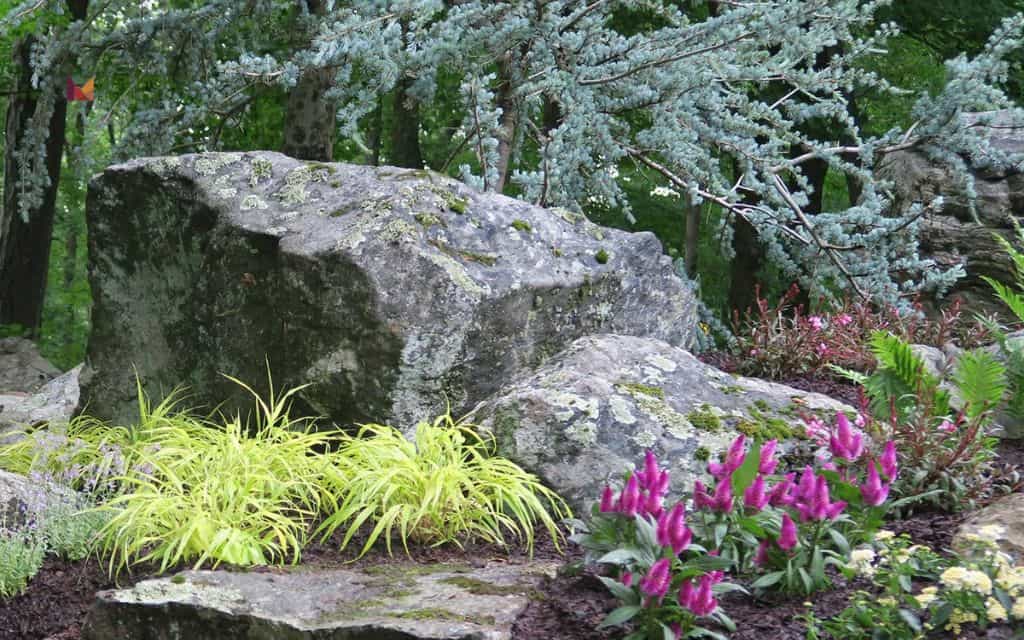
Dry creek bed for drainage
A naturalistic streambed using larger boulders (12 – 24 inches) for banks and smaller river stones (3 – 8 inches) for the bed transforms drainage issues into attractive features. This design directs runoff during storms while serving as striking hardscape when dry.
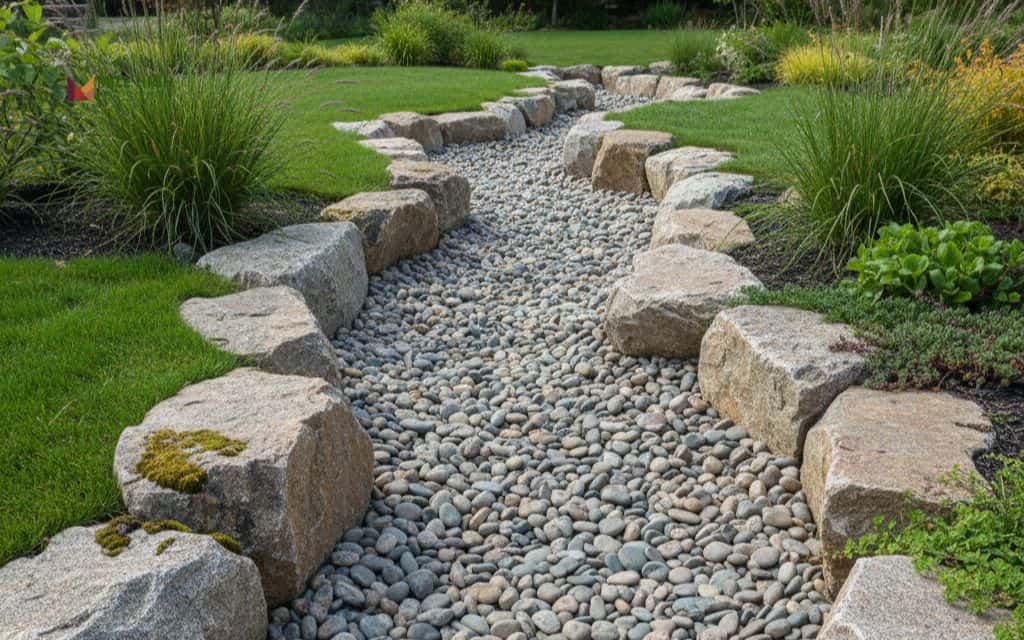
Black basalt modern front yard
Angular black basalt rock creates sophisticated minimalism perfect for contemporary homes. The dark stone provides a dramatic backdrop for architectural plants chosen for form: structural grasses, yuccas, and perhaps a single specimen tree or sculptural element.
Read more: 15+ stunning front yard landscaping ideas with rocks for Colorado area
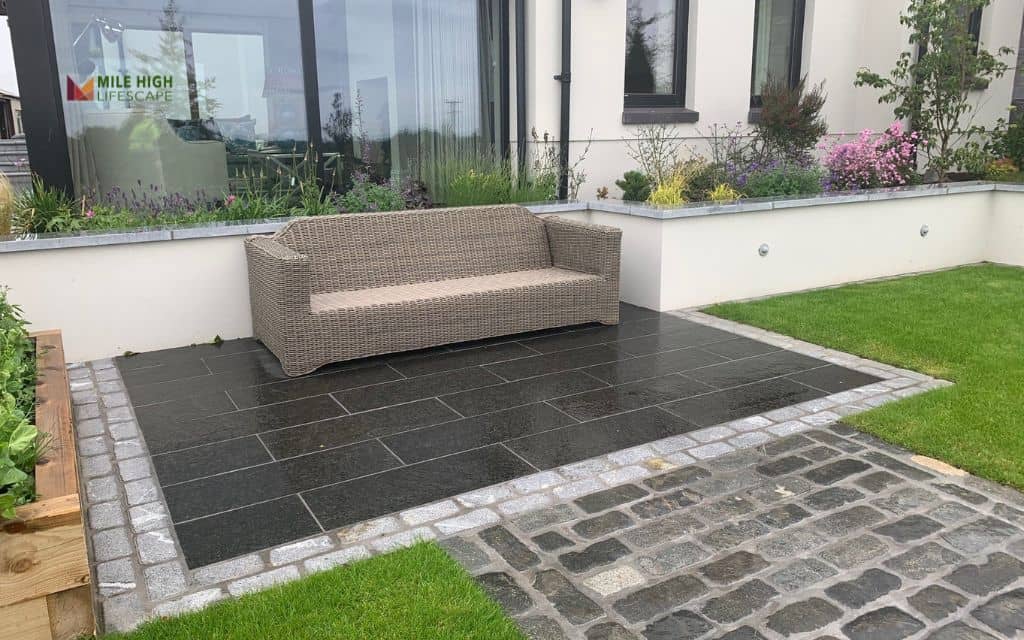
Pollinator-friendly mulch garden
Native flowering plants set in organic bark mulch attract butterflies, native bees, and hummingbirds. Colorado natives like coneflowers, penstemon, and bee balm provide nectar throughout the growing season, while 3-4 inches of mulch retains moisture and suppresses weeds.
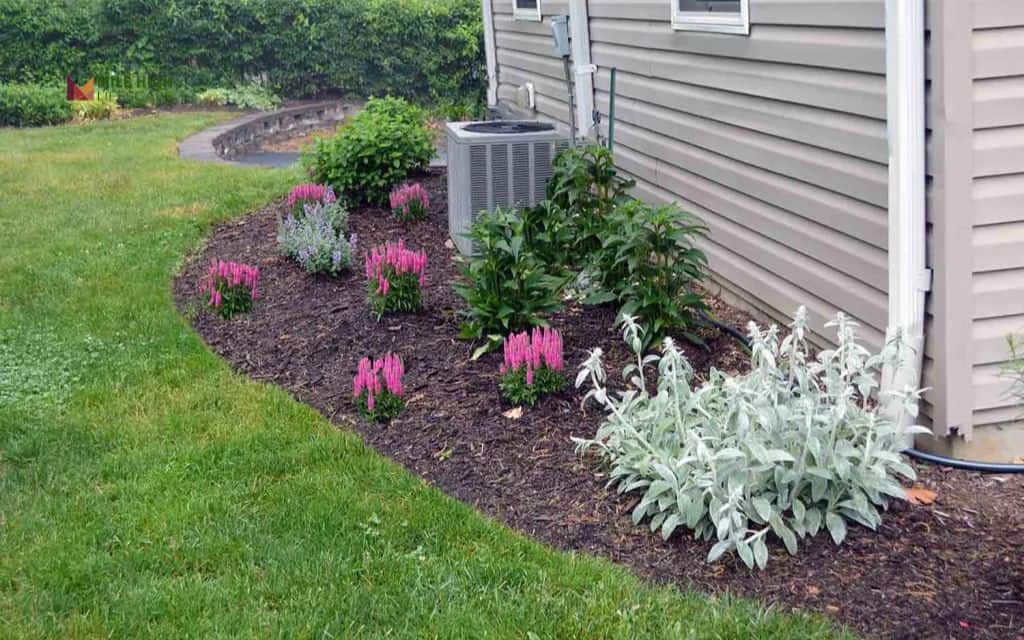
River pebble driveway borders
Smooth 1 – 3 inch river pebbles create 12 – 18 inch borders along driveways, preventing erosion and eliminating trimming challenges. The flexible material accommodates ground movement without damage and allows water infiltration during snowmelt.
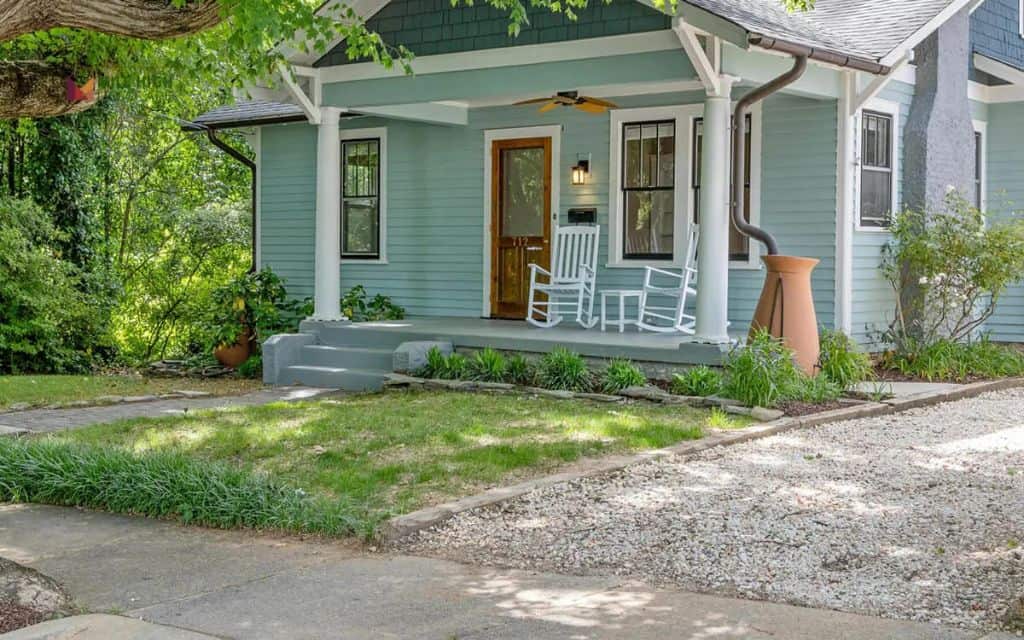
Tiered boulder and mulch slopes
Large boulders (2 – 4 feet diameter) partially buried on slopes create natural terraces that prevent erosion. Dark mulch fills the level areas behind each boulder, creating planting zones for groundcovers and grasses that stabilize soil.
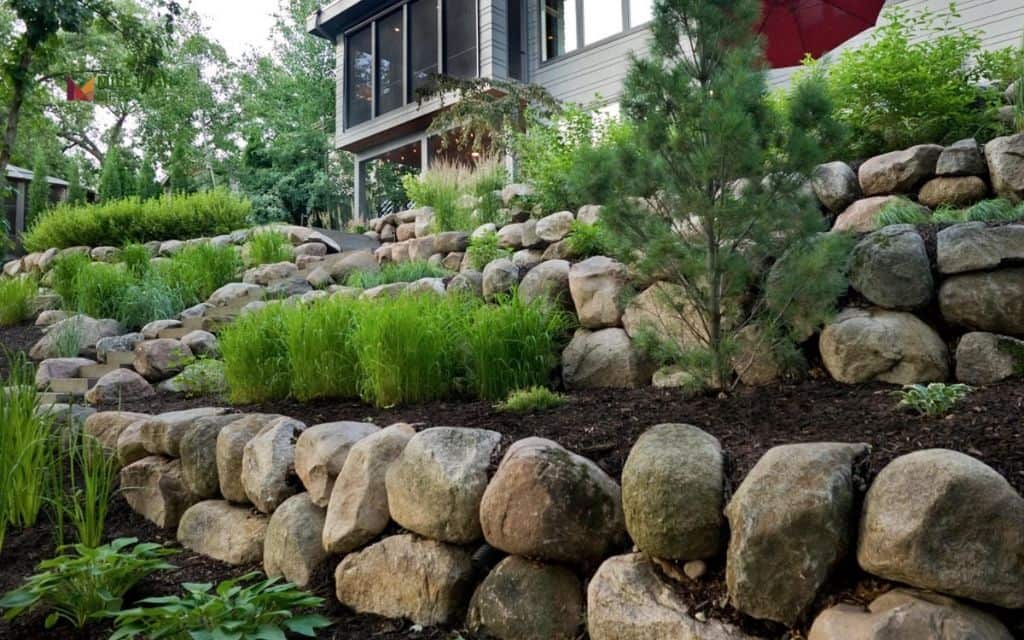
Fire-safe gravel perimeter
A 5 – 10 foot border of crushed gravel or pea stone creates fire-resistant buffer zones between structures and planted areas. This non-combustible material meets wildfire-safety recommendations for defensible space, particularly important near foothill areas.
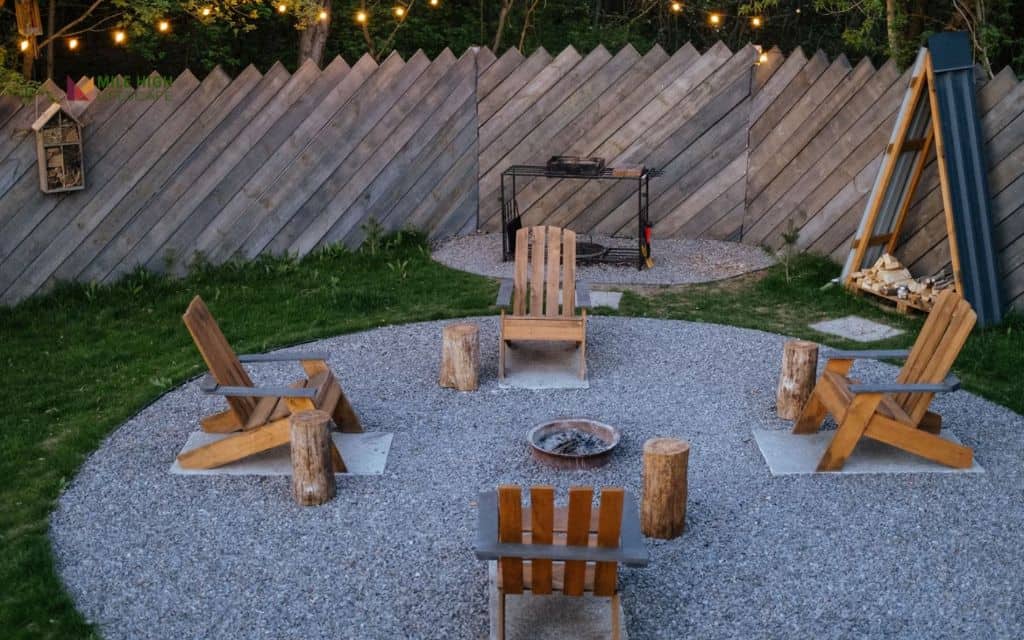
Mixed rock and mulch mosaic
Different materials create distinct zones through alternating patterns – river rock flows into mulched beds, then transitions to crushed granite areas. This approach assigns each material to its optimal function while creating visual movement.
Read more: 10 creative rock and mulch landscape ideas to replace traditional mulch in Denver
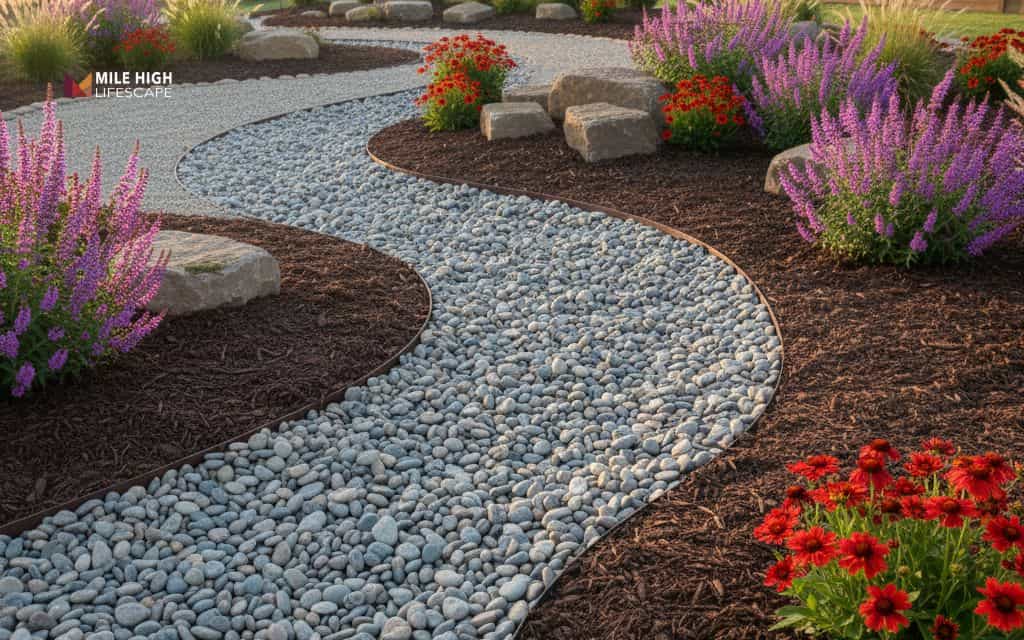
Colorado rustic design
Warm-toned Colorado moss rock or red sandstone combined with natural brown hardwood mulch echoes Front Range geology. Pair with native plants like blue spruce, serviceberry, and native grasses for an authentic mountain aesthetic.
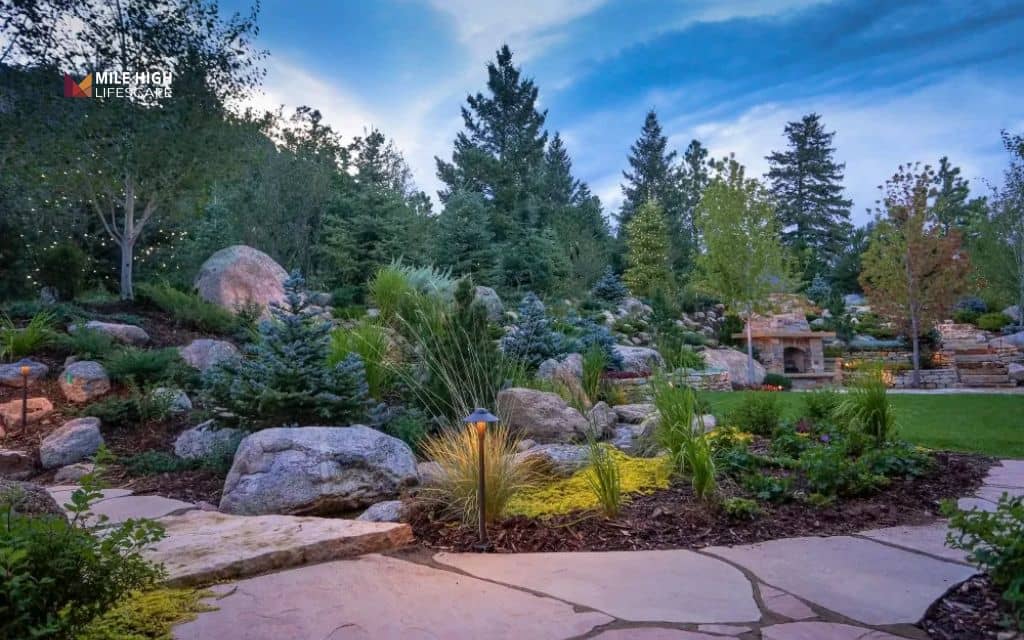
Low-water modern zen garden
Dark basalt rock creates tranquil minimalism inspired by Japanese zen rock gardens but adapted for Denver. Carefully placed ornamental grasses provide organic elements against horizontal rock fields, requiring almost no maintenance once established.
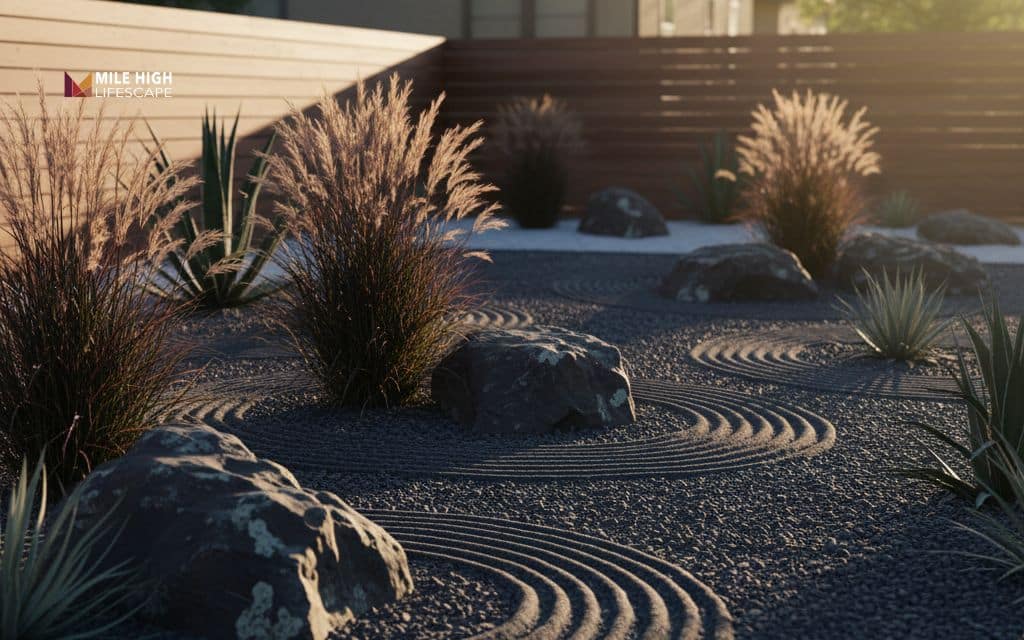
Prairie-style mulch and stone combo
Native grasses like little bluestem and prairie dropseed create naturalistic meadow effects with flowering perennials. Cobblestone edges define beds filled with organic mulch, embracing a looser aesthetic where plants self-seed naturally.
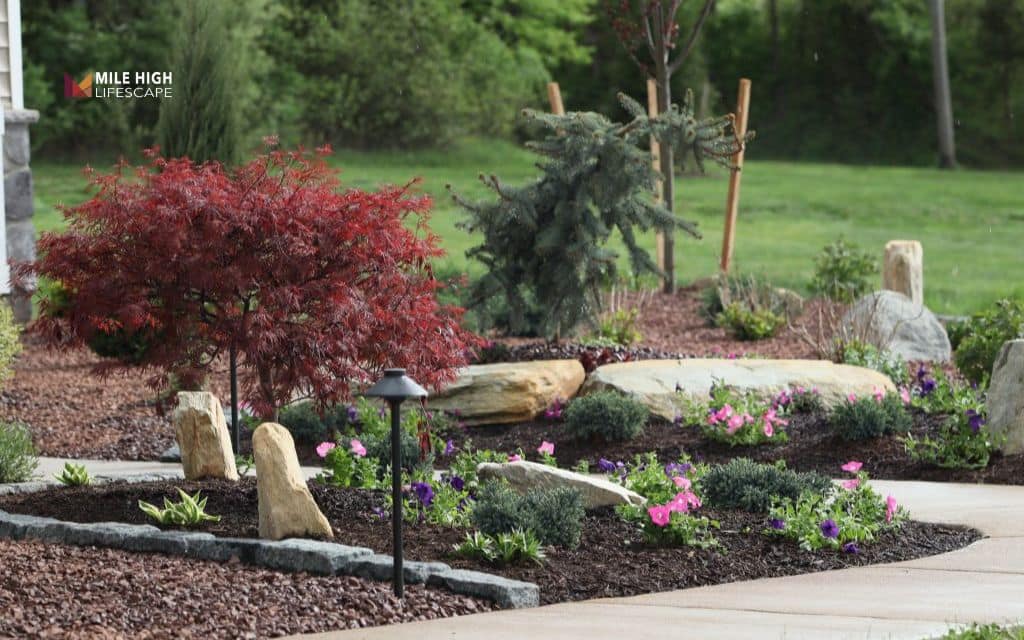
Solar-lit rock path
Decomposed granite or crushed stone pathways illuminated by solar stake lights combine sustainability with safety. Modern solar technology works well in Denver’s abundant sunshine, providing evening illumination without electrical costs.
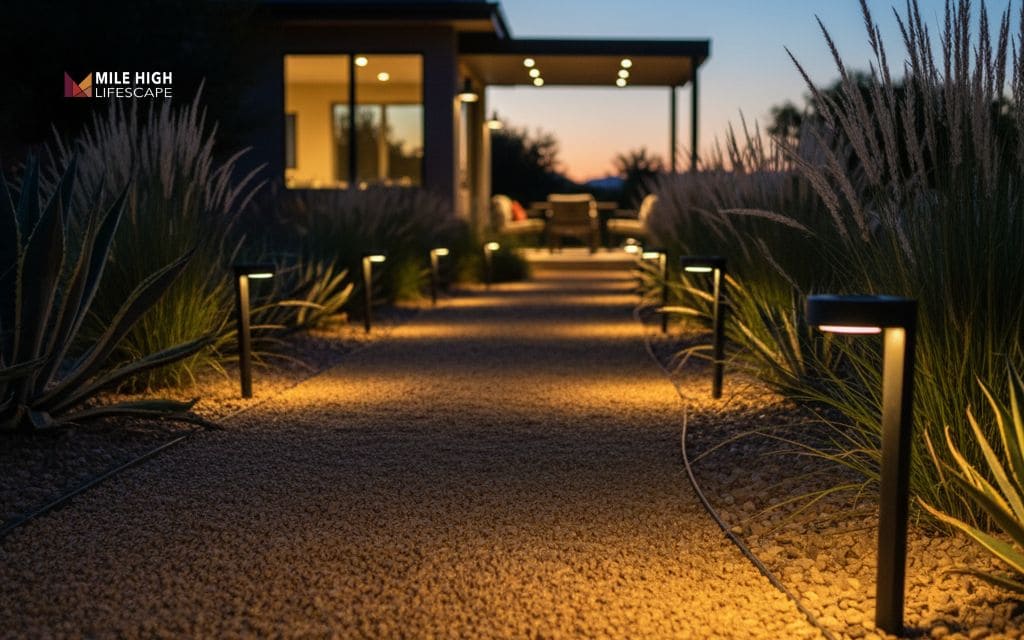
Boulder-centered front yard
One or several massive Colorado granite boulders (3 – 6 feet diameter) positioned as centerpieces create bold focal points. Surrounding mulch beds with native wildflowers and grasses make the weathered stones shine while requiring zero maintenance.
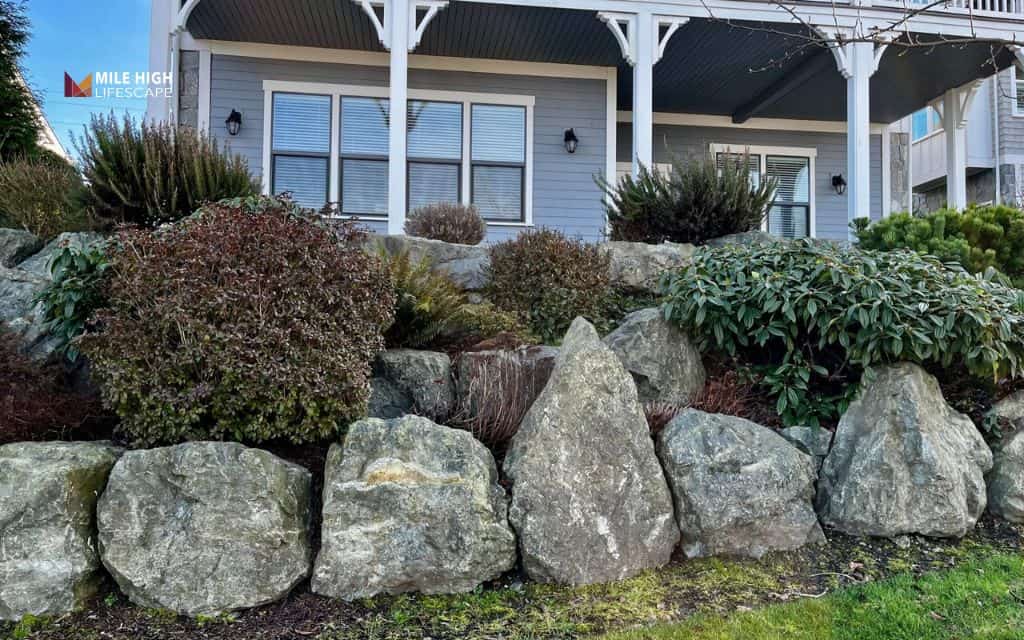
Maintenance tips for rock and mulch landscapes
Rock and mulch landscaping requires less maintenance than traditional lawns, but some regular attention keeps these landscapes looking their best and prevents small issues from becoming larger problems.
Mulch maintenance
Rake mulch lightly once monthly during the growing season to prevent matting and redistribute material that wind has displaced. Use a fan rake or leaf rake to avoid damaging landscape fabric underneath.
Refresh mulch every 1 – 2 years depending on material and exposure. In Denver’s dry climate, organic mulches decompose slower than in humid regions, so you may extend refreshing to 18 – 24 months in shaded areas. Add 1 – 2 inches of new mulch over existing layers.
Rock maintenance
Use leaf blowers or soft brooms to remove debris from rock areas rather than raking, which can displace stones. Denver’s cottonwood trees and spring winds create debris that should be cleared before it breaks down into soil.
Hose off rock areas 2 – 3 times yearly to remove accumulated dust and dirt that can dull appearance. This is especially important for light-colored rocks. A strong garden hose spray usually suffices.
Re-level rock areas every few years as materials naturally settle, particularly in pathways and high-traffic zones. Add fresh rock to maintain proper depth and fill depressions where settling has occurred.
Weed management
Despite landscape fabric and adequate material depth, some weeds will appear. Address weeds immediately when small – pull by hand when possible, removing entire root systems. For persistent weeds, spot-treat rather than using broad-spectrum chemicals.
Edging maintenance
Check edging annually for sections that have shifted from freeze-thaw cycles. Reset plastic or metal edging that has become loose. Maintaining defined edges preserves your design’s clean appearance.
Conclusion
These 17 front yard rock and mulch landscape pictures demonstrate that water-wise landscaping can be beautiful. By choosing rock and mulch landscaping, you’re investing in a front yard that reduces water consumption, eliminates hours of weekly lawn maintenance, and creates outdoor space that thrives in Denver’s weather rather than struggling against it. That’s sustainable beauty delivering real returns for years to come.
Mile High Lifescape – Your Denver Rock and Mulch Landscape Experts
For nearly two decades, Mile High Lifescape has transformed front yards with stunning rock and mulch landscapes built for Colorado’s climate. We handle everything from design to installation – river rock pathways, boulder placement, mulch beds, xeriscape gardens, and drainage solutions that actually work in our semi-arid conditions.
Our landscaping expert team delivers water-wise landscapes that slash your maintenance time, lower water bills, and increase curb appeal.
Ready to transform your front yard? Call Mile High Lifescape: (303) 877-9091
Frequently asked questions (FAQ)
What is better for landscaping, mulch or rocks?
Both materials serve different purposes, so using them together works best. Mulch excels near plants because it retains moisture, moderates soil temperature, and gradually enriches soil as it decomposes. Rocks provide durability and structure – ideal for pathways, edging, dry creek beds, and open areas.
How deep should rock or mulch be?
For rock applications, install 2 – 3 inches of depth over landscape fabric. This provides adequate weed suppression while allowing water to reach soil. Pathways need 3 – 4 inches of compacted crushed stone for durable surfaces.
Will rock make my yard hotter?
Yes, dark rocks absorb heat. This can stress nearby plants and create uncomfortable spaces. You can reduce heat effects by pairing dark rocks with light-colored mulch or lighter stones that reflect heat. Position heat-sensitive plants on north or east sides of dark rock areas for afternoon shade.
Will rock make my yard hotter?
Yes, dark rocks absorb heat. This can stress nearby plants and create uncomfortable spaces. You can reduce heat effects by pairing dark rocks with light-colored mulch or lighter stones that reflect heat. Position heat-sensitive plants on north or east sides of dark rock areas for afternoon shade.
How often should I refresh materials?
Organic mulches like cedar and hardwood need refreshing most frequently, 1-2 inches every 12-24 months. Shaded areas may last 24 months, while sun-exposed beds need annual attention. Decorative rocks last much longer, about 8-10 years. Large boulders and structural stones are essentially permanent – they require only occasional cleaning and rarely need repositioning.
